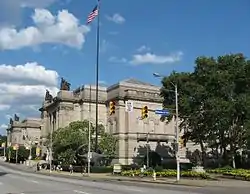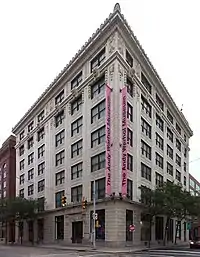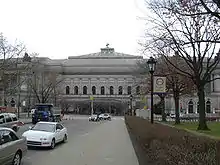Carnegie Museums of Pittsburgh
Carnegie Museums of Pittsburgh are four museums that are operated by the Carnegie Institute headquartered in the Carnegie Institute complex in the Oakland neighborhood of Pittsburgh, Pennsylvania. The Carnegie Institute complex that includes the original museum, recital hall, and library was added to the National Register of Historic Places on March 30, 1979.
Carnegie Institute and Library | |
 The Carnegie Institute serves as the headquarters of the Carnegie Museums | |
| Location | 4400 Forbes Ave., Pittsburgh, Pennsylvania |
|---|---|
| Coordinates | 40°26′34″N 79°57′2″W |
| Area | 9.5 acres (3.8 ha) |
| Built | 1895 |
| Architectural style | Beaux Arts |
| Part of | Schenley Farms Historic District (ID83002213) |
| NRHP reference No. | 79002158[1] |
| Significant dates | |
| Added to NRHP | March 30, 1979 |
| Designated CP | July 22, 1983[1] |
| Designated PHLF | 1970[2] |
Portfolio
Two of the Carnegie museums, the Carnegie Museum of Natural History and the Carnegie Museum of Art, are both located in the Carnegie Institute and Library complex in Oakland, a landmark building listed on the National Register of Historic Places (ref #79002158, added 1979).[3] It also houses the Carnegie Music Hall and the main branch of the Carnegie Library of Pittsburgh.[4] The other two museums, The Andy Warhol Museum and the Carnegie Science Center, are located in separate facilities on Pittsburgh's North Shore.[5]
Andy Warhol Museum

Opened on May 15, 1994, the Andy Warhol Museum is the first museum to exclusively focus on an American postwar artist.[6] The museum's collection includes over 4,000 Warhol art works in all media - paintings, drawings, prints, photographs, sculptures, and installation; the entire Andy Warhol Video Collection, 228 four-minute Screen Tests, and 45 other films by Warhol; and extensive archives, including Warhol's Time Capsules. While dedicated to Andy Warhol, the museum also hosts many exhibits by contemporary artists.
Carnegie Museum of Art

When Andrew Carnegie envisioned a museum collection consisting of the "Old Masters of tomorrow", the Carnegie Museum of Art became, arguably, the first museum of modern art in the United States. Founded in 1895, today it continues showcasing contemporary art by staging the Carnegie International exhibition every few years. Numerous works from the International exhibitions have been acquired for the museums' permanent collection including Winslow Homer's The Wreck (1896) and James A. McNeill Whistler's Arrangement in Black: Portrait of Señor Pablo de Sarasate (1884). The marble Hall of Sculpture replicates the interior of the Parthenon. The Hall of Architecture contains the largest collection of plaster casts of architectural masterpieces in America and one of the three largest in the world. The Heinz Architectural Center, opened as part of the museum in 1993, is dedicated to the collection, study, and exhibition of architectural drawings and models. In 2001 the museum acquired the archive of African-American photographer Charles "Teenie" Harris, consisting of approximately 80,000 photographic negatives spanning from the 1930s to the 1970s. Many of these images have been catalogued and digitized and are available online via the Carnegie Museum of Art Collections Search.
The museum's permanent collection includes European and American decorative arts from the late seventeenth century to the present, works on paper, paintings, prints (notably Japanese prints), sculptures and installations.
Carnegie Museum of Natural History

From the discovery of Diplodocus carnegii to the most complete Tyrannosaurus rex known to date passing by a brand new, yet-to-be-named species of oviraptorosaur, Carnegie Museum of Natural History displays 230 dinosaur objects. Other exhibits include Hillman Hall of Minerals and Gems, Alcoa Foundation Hall of American Indians, Polar World: Wyckoff Hall of Arctic Life, Walton Hall of Ancient Egypt, and Benedum Hall of Geology. The museum's Powdermill Nature Reserve was established in 1956 to serve as a field station for long-term studies of natural populations, and now forms the core of the museum's Center for Biodiversity and Ecosystems. Research teams including Carnegie scientists have made discoveries such as Puijila darwini, Castorocauda lutrasimilis, and Hadrocodium wui.
Carnegie Science Center

Opened in 1991, but with a history that dates to October 24, 1939, the Carnegie Science Center is the most visited museum in Pittsburgh. Among its attractions are the newly constructed Buhl Planetarium (which features the latest in digital projection technology), the Rangos Omnimax Theater, SportsWorks, the Miniature Railroad & Village, the USS Requin, a World War II submarine, and Roboworld.
The Buhl Planetarium and Carnegie Science Center merged in 1987 and in October 1989, the organizations broke ground on the new Carnegie Science Center building.[7]
References
- "National Register Information System". National Register of Historic Places. National Park Service. July 9, 2010. Retrieved October 4, 2016.
- "Internet Archive: Pittsburgh History and Landmarks Foundation: PHLF Plaques & Registries". 2007-01-27. Archived from the original on 2007-01-27. Retrieved 2009-07-11.
- "National Register of Historic Places Inventory Nomination Form: Carnegie Institute and Carnegie Library of Pittsburgh" (PDF). 1967. Retrieved 2010-06-08.
- "National Register of Historical Places - PENNSYLVANIA (PA), Allegheny County". National Register of Historic Places.com. Retrieved 2009-08-27.
- "Carnegie Museums of Pittsburgh | Events & Facility Rentals". www.carnegiemuseums.org. Retrieved 2017-08-24.
- Smith, Roberta (1994-05-26). "Review/Art; The New Warhol Museum: A Shrine for an Iconoclast". The New York Times. ISSN 0362-4331. Retrieved 2018-12-04.
- "Carnegie Science Center: Our History". www.carnegiesciencecenter.org. Retrieved 2018-12-04.
External links
- Official website
- Andy Warhol Museum
- Carnegie Museum of Art
- Carnegie Museum of Natural History
- Carnegie Science Center
| Wikimedia Commons has media related to Carnegie Museums of Pittsburgh. |
